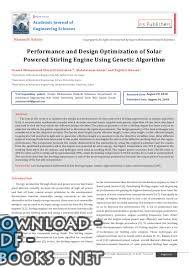📘 قراءة كتاب Performance and Design Optimization of Solar Powered Stirling Engine Using Genetic Algorithm أونلاين


كتب الهندسة
Performance and Design Optimization of Solar Powered Stirling Engine Using Genetic Algorithm
by Osama Mohammed Elmardi Suleiman
Contact photoAttachments
Show options
Message Body
The aim of this work is to optimize the design and performance of solar powered γ Stirling engine based on genetic algorithm
(GA). A second-order mathematical model which includes thermal losses coupled with genetic algorithm GA has been developed
and used to find the best values for different design variables. The physical geometry of the γ Stirling engine has been used as an
objective variable in the genetic algorithm GA to determine the optimal parameters. The design geometry of the heat exchanger was
considered to be the objective variable. The heater slots height, heater effective length, cooler slots height, cooler effective length,
re-generator foil unrolled length and re-generator effective length are assumed to be the objective variables. Also, three different
types of working fluids have been used in the model simulation to investigate the effect of the different working fluid on the engine
performance. The comparison between the results obtained from the simulation by using the original parameters and the results
from the optimized parameters when the engine was powered by solar energy; the higher temperature was 923 K applied to the
working fluid when the air, helium, and hydrogen were used as working fluid. The engine power increases from 140.58 watts to
228.54 watts, and it is enhanced by approximately 50%, when the heating temperature is 923 K and the air is used as working fluid.
The result showed that the working temperature is one of the most important parameters; because the output power increases by
increasing of the hot side temperature.
Citation: Osama Mohammed E S, Abdalazeem A, Tagelsir H. Performance and Design Optimization of Solar Powered
Stirling Engine Using Genetic Algorithm. Acad J Eng Sci. 1(1): 2018. AJES.MS.ID.000501.
Page 1 of
Performance and Design Optimization of Solar
Powered Stirling Engine Using Genetic Algorithm
Osama Mohammed Elmardi Suleiman1*, Abdalazeem Adam2 and Tagelsir Hassan3
1Department of Mechanical Engineering, Nile Valley University, Sudan
2Department of Mechanical Engineering, Karary University, Sudan
3Department of Mechanical Engineering, Omdurman Islamic University, Sudan
Introduction
Energy production through clean and green sources has found
great interest recently, because the proportion of high oil prices
and fuel oil have caused severe problems to the environment.
Researchers consider renewable energy resources as the best
alternative to the trendy energy sources, these source of renewable
energy it can be used as an input energy source for heat the Stirling
engines [1,2]. Stirling engines are mechanical devices theoretically
working on the Stirling cycle and using a compressible fluid, such
as air, helium, hydrogen and nitrogen. They can also use vapors
as working fluid [3,4]. `Stirling engines have been used in various
types of applications such as energy converters for Stirling/Dish,
coolers, and heat pumps, residential CHP etc. In recent years they
were applied in the renewable energy fields. The Stirling engine
systems design and development has been signified for combined
heat and power systems [5]. In fact, the Stirling engines are friend
to the environment than the internal combustion engines so that it
found great interest [6]. Developing Stirling engine and improving
its performance for getting its highest thermal power have been the
concern of some researchers around the world [4,7]. Principally to
design an engine, firstly has to find a set of parameters based on
experiences and secondly optimize the design for other parameters
so as to improve the performance [8]. A lot of parameters like
power piston and displacer geometries, heat exchanger geometries,
temperatures, pressure, engine working frequency, have direct
effect on the engine output power and efficiency and hence, they
complicate the design procedure [5]. To understand the working
fluid thermodynamic behavior of Stirling engines, there are a lot
of techniques for Stirling cycle analysis. These techniques are
categorized from zero to fourth order analysis [9-11]. Rajesh Arora
et al. [12] optimized power output, overall thermal efficiency and
thermo-economic function of solar powered Stirling heat engine
*Corresponding author: Osama Mohammed Elmardi Suleiman, Department of
Mechanical Engineering, Nile Valley University, Atbara, River Nile, Sudan, Email:
Received Date: August 20, 2018
Published Date: August 30, 2018
Academic Journal of
Engineering Sciences
Open Access
Research Article Copyright © All rights are reserved
Abstract
The aim of this work is to optimize the design and performance of solar powered γ Stirling engine based on genetic algorithm
(GA). A second-order mathematical model which includes thermal losses coupled with genetic algorithm GA has been developed
and used to find the best values for different design variables. The physical geometry of the γ Stirling engine has been used as an
objective variable in the genetic algorithm GA to determine the optimal parameters. The design geometry of the heat exchanger was
considered to be the objective variable. The heater slots height, heater effective length, cooler slots height, cooler effective length,
re-generator foil unrolled length and re-generator effective length are assumed to be the objective variables. Also, three different
types of working fluids have been used in the model simulation to investigate the effect of the different working fluid on the engine
performance. The comparison between the results obtained from the simulation by using the original parameters and the results
from the optimized parameters when the engine was powered by solar energy; the higher temperature was 923 K applied to the
working fluid when the air, helium, and hydrogen were used as working fluid. The engine power increases from 140.58 watts to
228.54 watts, and it is enhanced by approximately 50%, when the heating temperature is 923 K and the air is used as working fluid.
The result showed that the working temperature is one of the most important parameters; because the output power increases by
increasing of the hot side temperature.
Keywords: Low temperature differential (LTD) Stirling engine; Genetic algorithm (GA); Coolers and heat pumps (CHP)
سنة النشر : 2018م / 1439هـ .
حجم الكتاب عند التحميل : 696 كيلوبايت .
نوع الكتاب : pdf.
عداد القراءة:
اذا اعجبك الكتاب فضلاً اضغط على أعجبني و يمكنك تحميله من هنا:

شكرًا لمساهمتكم
شكراً لمساهمتكم معنا في الإرتقاء بمستوى المكتبة ، يمكنكم االتبليغ عن اخطاء او سوء اختيار للكتب وتصنيفها ومحتواها ، أو كتاب يُمنع نشره ، او محمي بحقوق طبع ونشر ، فضلاً قم بالتبليغ عن الكتاب المُخالف:
 قبل تحميل الكتاب ..
قبل تحميل الكتاب ..
يجب ان يتوفر لديكم برنامج تشغيل وقراءة ملفات pdf
يمكن تحميلة من هنا 'http://get.adobe.com/reader/'


 منصّة المكتبة
منصّة المكتبة 